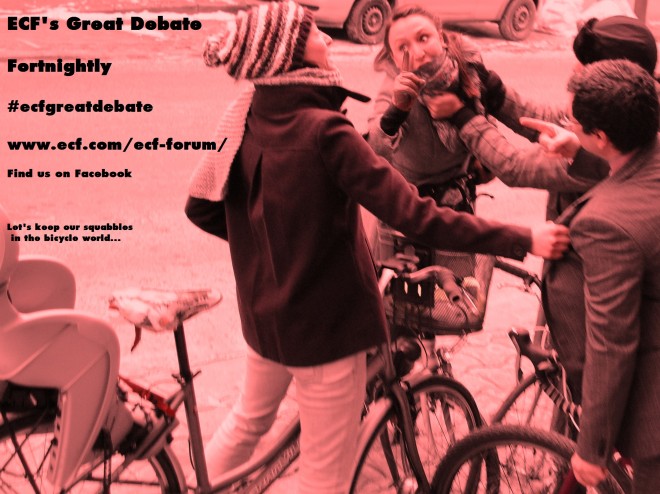
The Great Debate
When is a bicycle superhighway a superhighway?
This is the first edition of our Great Debate. Go to the end of the article to see how you can have your voice heard.

This is what a "bicycle motorway" could look like the Swedish Newspaper, Sydsvenskan, illustrates. Read more
New plans for a bicycle superhighway in Southern Sweden have been in headlines recently, Malmö, Sweden’s third largest city will be connected with the lively college town, Lund, 20km further north. As a former Malmö resident, I wondered what the fuss was all about, because really: there’s already fine infrastructure connecting the two cities. I’ve tried it myself and it worked irreproachably. I probably wouldn’t cycle back and forth every day though. Well, perhaps I would, but only if the old promise of tailwind on all bicycle paths was introduced in Sweden as well, as was promised by a Danish Politician in the 1990s.
Reading a little more into the Swedish Bicycle Superhighway plans I’m starting to wonder if this is actually a “tailwind vision” coming true. The proposed bicycle superhighway will, in addition to having two types of wind protection (low bushes as well as solid fencing), have four lanes (2 in each direction), have exits but no intersections, periodic bicycle service stations, and will take eight years to complete. Total cost of the superhighway is estimated to be about 50 million Swedish crowns (US$ 7.1 million). Perhaps not quite a tailwind promise, but about as close as you can get.
Sweden is not alone in (hopefully) building bicycle superhighways. Several Danish cities are working on similar plans and all over The Netherlands, in London, UK, and even as far south as Brisbane, Australia, superhighways have already become a reality. But despite sharing the same name, bicycle superhighways differ greatly.
What is a bicycle superhighway?
No doubt about it, bicycle superhighways are on the rise, but an important question remains: how do you define a bicycle superhighway? Well, apart from being a cycle route that, like a (automobile) superhighway, is supposed to be an as continuous and direct link between two popular commuting points as possible, then nothing really!
Dutch bicycle ambassador, Marc von Woudenberg from Amsterdamize tells me how the Dutch have
|
From David Hembrow and Mark Wagenbuurs blog A view from the cycle path |
standardized their bicycle superhighways (known in dutch as ‘fietssnelwegen’). A Dutch bicycle superhighway for up to 2.500 cyclists per day, for example, needs to be surfaced with red asphalt, be 4 meters wide, have lighting along the entire route, have rest stops with shelters every 2 km, incline max 3%, etc.
According to Marc, the premise behind these superhighways is to “provide incentives for people to ditch their car on longer routes/commutes, supported by the growing number of people using e-bikes”
Marc also tells me that “It's about seizing the shift in the decision making process of users: now more based on the time factor than on the distance factor”. Targeting the long distance commuters also is the logic behind the Danish and Swedish initiatives. In Copenhagen the target group is both potential and existing suburban cyclists commuting more than 10km each way.
| Londons Barclay bicycle superhighways |
London’s Superhighways
Compared to the Dutch, the London superhighway vision is a little different. As Mayor Boris Johnson explains in a promotional video “the key thing is to convince people that this is somewhere where motorists can expect to find cyclists. The motorists can’t just shovel the cyclists out of their way. This is a road, a highway where you’re just going to find loads of people riding their bikes. And that’s the name of the game!”
The underpinning ideology behind London’s bicycle superhighways seems to concern attitudes and behavior, and less a practical commuting matter. Which of course makes sense, when London only has a mode share around 2% while the mode share in the Netherlands, Denmark and Southern Sweden is at least tenfold that amount.
|
Video from The Grumpy Cyclist |
The London bicycle superhighways do also have colored surfaces, signs and many safety precautions installed along the route, the infrastructure is not consistent though. Despite the good initiative the London bicycle superhighways have been criticized for being far too dangerous by many bicycle advocates (links) and when a cyclist was killed on one of the routes it was grist to their mill. When watching some of the route, I must say, as a native Dane, I personally don’t find the bicycle highway that ‘super’ either:
International term calls for international standardization?
Whether or not one prefers the Dutch or the London interpretation of a bicycle superhighway, I wonder how infrastructure can be so different and still go by the same name. I asked ECF’s Road Safety Policy Officer, Ceri Woolsgrove, why terms like this haven’t been internationally standardized:
“For this to work as a standard perhaps an important condition should be that there is already some level of similar development and style of the thing to be standardised. It is debatable whether that exists across Europe yet. As Sidsel points out the difference between the Dutch and UK ‘superhighways’ is pretty vast. The dilemma remains that if we look to standardise something called a bicycle superhighway do we shoot for the moon and go for a great standard that no one except the most advanced countries will apply; or do we go for a standard that isn’t the best but which more countries will adopt? We also have another problem in that we have 27 different countries and what would work in one country might not work in another country, for example the Dutch superhighways tend to exist apart from the road while those in the UK exist on the roads with all the legal baggage that this entails” says Ceri.
It’s all in the name: Terminology
It’s worth asking if the term “bicycle superhighway” is adequate. When it comes to infrastructure, Jens-Erik Larsen from Foreningen Frie Fugle, one of ECF’s Danish members, has been a proponent of definition clarity for many years (find some of his definitions here) He’s not amused by the term: “Even though the word highway is older than the automobile, superhighway connotes motorized traffic, and I don’t understand why it has to stay in the auto centric terminology” Jens Erik Says. (Note how the Swedish newspaper has called the superhighway a “cycle motorway”)
“Also I think the term route is more precise (than highway or path) since it is not only one path but many paths linked together and physically marked as a route.” To Jens Erik long distance commuting route is more precise but not very catchy, which he notes is very important as well.
“When you promote a new phenomenon and give it a name you should be very careful what name you pick, because words have a lot of power. Take Copenhagenize for instance, the word was invented by Mikael Colville-Andersen only a few years ago and has spread all over the world and given a lot of media attention to Copenhagen. A good name is catchy, precise and easy to pronounce!
Who doesn’t like super?
Already, bicycle superhighways is a pretty integrated term in the journalistic lingo and since the adjective “super” has a good spotlight effect planners and politicians have become fond of the term as well. The question remains though, if the broad definition of the term risks making it an empty phrase and if the term is named properly – does anyone have a better suggestion? Or: should we just enjoy the fact that every time a new place decides to build bicycle superhighways (whatever that may mean) it gets a tremendous amount of media attention, which befits the cycling world.
So friends out there in the bicycle community, tell us, when is a bicycle superhighway a superhighway? Is using ‘superhighway’ an appropriate term for bicycle infrastructure? And should we standardize such infrastructure.
Let us know what you think…
How can you Join the Debate?
We can’t wait to hear your opinion: Tweet #ecfgreatdebate and tell us what you think
Post on our ‘The Great Debate on Bicycle Superhighways' forum discussion and also have your say on our Facebook page.
You can also send us an email with the subject line: Superhighway to communications@ecf.com, and we’ll post you’re query on our forum.
Feel the need to read more?:
An international dialogue about Bicycle Superhighways (in German and English): http://www.metropolregion.de/pages/themen/mobilitaet/fachdialog_radschnellwege/index.html
Brisbanes Bicycle Superhighway: http://www.brisbanetimes.com.au/queensland/brisbane-bike-super-highway-opens-20111223-1p89e.html
The Danish Bicycle Superhighways: http://supercykelstier.dk/dk/cykelsuperstierdk.htm
Sidsel Birk Hjuler is the communications assistant at ECF. Sidsel has a MA in Modern Culture and Cultural Communication, University of Copenhagen, and has been studying emerging bicycle cultures and the cycling experience of different international city infrastructures in sociological perspective.
She thinks that cycling, as a mode of transportation, significantly improves urban life.
Contact the author
Recent news!
Upcoming events
Contact Us
Avenue des Arts, 7-8
Postal address: Rue de la Charité, 22
1210 Brussels, Belgium












